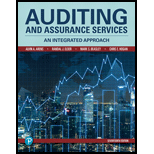
Auditing And Assurance Services
17th Edition
ISBN: 9780134897431
Author: ARENS, Alvin A.
Publisher: PEARSON
expand_more
expand_more
format_list_bulleted
Question
Chapter 22, Problem 18.2MCQ
To determine
Indicate the person from whom an auditor can obtain written confirmation regarding debenture transactions during an audit of a publicly held company.
Expert Solution & Answer
Want to see the full answer?
Check out a sample textbook solution
Students have asked these similar questions
Determine the number of units must sell in 2023
Can you explain this financial accounting question using accurate calculation methods?
What is the ending total assets balance?
Chapter 22 Solutions
Auditing And Assurance Services
Ch. 22 - List four examples of interest-bearing liability...Ch. 22 - Prob. 2RQCh. 22 - Prob. 3RQCh. 22 - Prob. 4RQCh. 22 - Prob. 5RQCh. 22 - Distinguish between (a) tests of controls and...Ch. 22 - Prob. 7RQCh. 22 - Prob. 8RQCh. 22 - Prob. 9RQCh. 22 - Prob. 10RQ
Ch. 22 - Prob. 11RQCh. 22 - Prob. 12RQCh. 22 - Prob. 13RQCh. 22 - Prob. 14RQCh. 22 - Prob. 15RQCh. 22 - Explain the relationship between the audit of...Ch. 22 - Prob. 17.1MCQCh. 22 - Prob. 17.2MCQCh. 22 - Prob. 17.3MCQCh. 22 - Prob. 18.1MCQCh. 22 - Prob. 18.2MCQCh. 22 - Prob. 18.3MCQCh. 22 - Prob. 19.1MCQCh. 22 - Prob. 19.2MCQCh. 22 - Prob. 19.3MCQCh. 22 - Prob. 20DQPCh. 22 - Prob. 21DQPCh. 22 - Prob. 22DQPCh. 22 - Prob. 23DQPCh. 22 - Prob. 24DQPCh. 22 - Prob. 25DQPCh. 22 - Prob. 26DQPCh. 22 - Prob. 27DQPCh. 22 - Prob. 28DQPCh. 22 - Prob. 29DQPCh. 22 - Prob. 30DQP
Knowledge Booster
Similar questions
- Can you solve this financial accounting question using valid financial methods?arrow_forwardCan you explain the correct methodology to solve this general accounting problem?arrow_forwardI am looking for the correct answer to this general accounting question with appropriate explanations.arrow_forward
- Compute the correct Cost of goods sold for 2023.arrow_forwardA piece of equipment is purchased for $34,750 and has a salvage value of $4,350. The estimated life is 8 years and the method of depreciation is straight-line. Shipping costs total $950 and installation costs are $820. The book value at the end of year 8 is_. a. $3,110 b. $3,200 c. $2,000 d. $4,350arrow_forwardWestland Corporation's cost of goods manufactured last month was $195,000. The beginning finished goods inventory was $42,000 and the ending finished goods inventory was $39,000. Overhead was underapplied by $6,000. Any underapplied or overapplied manufacturing overhead is closed out to cost of goods sold. How much is the adjusted cost of goods sold on the Schedule of Cost of Goods Sold?arrow_forward
- Can you help me solve this general accounting problem using the correct accounting process?arrow_forwardFleetwood Manufacturing has provided the following data for the month of May. The balance in the Finished Goods inventory account at the beginning of the month was $94,200 and at the end of the month was $89,300. The cost of goods manufactured for the month was $428,700. The actual manufacturing overhead cost incurred was $152,800 and the manufacturing overhead cost applied to jobs was $158,400. The adjusted cost of goods sold that would appear on the income statement for May is __.arrow_forwardPlease provide the correct answer to this general accounting problem using accurate calculations.arrow_forward
arrow_back_ios
SEE MORE QUESTIONS
arrow_forward_ios
Recommended textbooks for you
 Auditing: A Risk Based-Approach (MindTap Course L...AccountingISBN:9781337619455Author:Karla M Johnstone, Audrey A. Gramling, Larry E. RittenbergPublisher:Cengage Learning
Auditing: A Risk Based-Approach (MindTap Course L...AccountingISBN:9781337619455Author:Karla M Johnstone, Audrey A. Gramling, Larry E. RittenbergPublisher:Cengage Learning Auditing: A Risk Based-Approach to Conducting a Q...AccountingISBN:9781305080577Author:Karla M Johnstone, Audrey A. Gramling, Larry E. RittenbergPublisher:South-Western College Pub
Auditing: A Risk Based-Approach to Conducting a Q...AccountingISBN:9781305080577Author:Karla M Johnstone, Audrey A. Gramling, Larry E. RittenbergPublisher:South-Western College Pub

Auditing: A Risk Based-Approach (MindTap Course L...
Accounting
ISBN:9781337619455
Author:Karla M Johnstone, Audrey A. Gramling, Larry E. Rittenberg
Publisher:Cengage Learning

Auditing: A Risk Based-Approach to Conducting a Q...
Accounting
ISBN:9781305080577
Author:Karla M Johnstone, Audrey A. Gramling, Larry E. Rittenberg
Publisher:South-Western College Pub